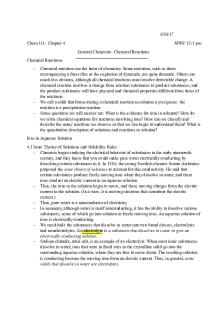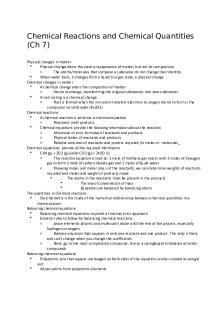Chem Test 2 Review Chemical Reactions PDF

| Title | Chem Test 2 Review Chemical Reactions |
|---|---|
| Course | Chemistry |
| Institution | High School - Canada |
| Pages | 5 |
| File Size | 221.6 KB |
| File Type | |
| Total Downloads | 65 |
| Total Views | 169 |
Summary
Notes...
Description
Chemical Reactions Unit Test 4.1 Introduction to Chemical Reactions - What is a chemical reaction? o A chemical reaction is when 1+ substances undergo a chemical change to produce 1+ new substances - What are some observations that might indicate that a chemical reaction has taken place? o Observations that may indicate a chemical reaction are: unexpected change in colour, energy is released or absorbed, gas is produced, a precipitate forms. - What is a precipitate? o A precipitate is a solid produced when 2 liquids are combined. - What is a catalyst? o A catalyst is a substance that speeds up the reaction, without being used up in the reaction. - Know the format for writing chemical equations using either chemical names or chemical formulas - Know the state symbols (eg. (s), (l), (g), (aq)) - What is the law of conservation of mass? o The law of conservation of mass states matter cannot be created or destroyed, and thus the total mass of the reactants equals the total mass of products - Know how to balance chemical equations 4.2 Synthesis and Decomposition Reactions - Know the definitions of synthesis and decomposition reactions o Synthesis: A reaction in which two reactants combine to make a large/more complex product Decomposition: A reaction in which a large/more complex compound breaks down to form two (or more) simpler products Know the generic equations of synthesis and decomposition reactions o
-
-
o
Synthesis reaction: A + B → AB
o
Decomposition reaction: AB → A + B
See PowerPoint lesson Know the different types of common synthesis and decomposition reactions o Synthesis: ▪ Element + element → compound ▪ Element + compound → compound (if OG element is in compound reactant) ▪ Compound + compound → compound ● Acidic oxide + water → acid ● Basic oxide + water → base ● Acidic oxide + basic oxide → salt o
Decomposition ▪ Binary compound → elements ▪ Metal nitrate → metal nitrite + oxygen gas ▪ Metal oxide → metal + oxygen ▪ Metal carbonate → metal oxide + carbon dioxide
▪ Metal hydroxide → metal oxide and water 4.4 Single Displacement Reactions - Know the definition for a single displacement reaction o A reaction in which an element displaces another element in a compound, producing a new compound and a new element - Know the generic equation for a single displacement reaction o -
-
A + BC → AC + B
Know how to use the activity series to predict whether or not a single displacement reaction will occur (for metals, acids, water, and halogens), and how quickly the reaction will occur o Activity Series: An element HIGHER (more reactive) on the list can displace elements below it from compounds, but not ones above it. o The farther apart the two elements are, the more likely that the reaction will occur quickly Know the different types of common single displacement reactions studied (all use activity series): o Metal + compound → metal + compound o
Halogen + compound → halogen + compound
o
Metal + water → hydrogen gas + base (metal + OH) ▪ i.e. 2Na(s) + 2H2O(l) → H2(g) + 2NaOH
o
Metal + acid (hydrogen + nonmetal) → hydrogen gas + ionic compound ▪ i.e. Li(s) + H2SO4(aq) → H2(g) + Li2SO4(aq)
4.6 Double Displacement Reactions - Know the definition of a double displacement reaction o A reaction in which elements in two compounds displace each other and produce two new compounds - Know the generic equation of a double displacement reaction o -
AB + CD → AD + BC
Know how to use the solubility table to predict the solubility of an ionic compound Know the different types of common double displacement reactions studied: o Precipitate Forms - Compound + compound (check solubility table, if both products are soluble, no precipitate) o
Gas Forms - Occurs with sulfide, carbonate, or sulfite with an acid Types of gas produced - Sulfide → hydrogen sulfide - Carbonate → carbon dioxide (through decomposition of carbonic acid into water as well) - Sulfite → sulfur dioxide (through decomposition of sulfurous acid into water as well)
o
Neutralization - Acid + base → water + ionic compound - Base can be a hydroxide or carbonate
- If with a carbonate, compound decomposes and additional product of CO 2
5.1 The Combustion of Hydrocarbons - What is combustion? What are organic compounds? What are hydrocarbons? o Combustion: A chemical reaction in which a fuel burns in oxygen o Organic compound : A molecular compound containing 1+ carbon-hydrogen bonds; usually what most fuels are composed of. o Hydrocarbon: An organic compound consisting entirely of hydrogen and carbon -
-
What is complete combustion? o The combustion/burning of a hydrocarbon in plentiful supply of oxygen to produce carbon dioxide, water, and energy. Controlled/ideal conditions What is the general chemical equation for the complete combustion of a hydrocarbon? o
CxHy + O2(g) → CO2(g) + H2O(g) + energy
-
Why is complete combustion often desirable over incomplete combustion? o Produces cleanest and hottest flames, releases more energy
-
What is incomplete combustion? o The combustion/burning of a hydrocarbon in limited supply of oxygen, with various products.
-
o
Occurs when hydrocarbon is in enclosed space. Uncontrolled/less than ideal conditions
o
“Fuel-rich”: lots of fuel require, limited oxygen
What are some of the possible products of the incomplete combustion of a hydrocarbon? o Carbon (soot), carbon monoxide, carbon dioxide, water, energy Why is incomplete combustion often less desirable over complete combustion? Name one instance when incomplete combustion is more desirable than complete combustion. o Only portion of energy released by reaction may be obtained. o
Soot particles are inhalation hazard causing respiratory problems - toxic, not filterable
o o
Carbon monoxide poisoning USEFUL: Cold lawn mower is easier to start if a fuel-rich mixture enters the engine
5.3 Elements and Their Oxides - What is an oxide, acid, base, acidic oxide, and basic oxide? o Oxide: A compound composed of oxygen and another element o
Acid: A compound that produces hydrogen ions when mixed with water
o
Base: A compound that produces hydroxide ions when mixed with water
Acidic Oxide: An oxide that forms an acidic solution when dissolved in water; molecular compounds that are often gases at room temperature; NON-METALLIC OXIDE o Basic Oxide: An oxide that forms a basic solution when dissolved in water; ionic compounds that are often solids at room temperature; METALLIC OXIDE What is the pH scale? Do acids and bases have low pH values or high pH values? o pH scale indicates the concentration of hydrogen ions present in a solution o
-
o
Acids - low pH, base - high pH hello child i come from the wild west yeeeeHWAA
-
-
-
List 3 elements that can form acidic oxides. Know the chemical equations for the formation of these oxides. o Sulfur oxides: S(s) + O2(g) → SO2(g) and 2SO2(g) + O2(g) → 2SO3(g) o
Nitrogen oxides: N2(g) + O2(g) → 2NO(g)
o
Carbon oxides: C(s) + O2(g) → CO2(g)
and 2C(s) + O2(g) → 2CO(g)
What is a catalytic converter and how does it work? o It prevents most of nitrogen oxides and other pollutants from being discharged in the exhaust of a car, since it is can form toxic respiratory irritants after leaving the exhaust of a car. ▪ The interior is coated with beads of platinum, palladium or rhodium catalyst, which when in contact decomposes the nitrogen oxides to nitrogen and oxygen (harmless) Know one example of a basic oxide and the chemical formula for its formation. What are some uses of basic oxides? o 4Na(s) + O2(g) → 2Na2O (s) + energy o
-
and 2NO(g) + O2(g) → 2NO2(g)
Uses of basic oxides: detergent, paper, glass, cement, paper
See PowerPoint lesson
5.4 Neutralization Reactions - What are neutralization reactions? o When an acid reacts with a base to produce a solution with a pH closer to 7. Products are water and ionic compound (usually salt): o Acid + base → water + ionic compound - What are two different ways to neutralize an acidic solution o With a hydroxide compound (OH) o -
With a carbonate compound (CO3)
Understand how the neutralization of an acidic solution with a carbonate compound is a 2 step reaction o After the double displacement, the carbonic acid immediately decomposes to water and carbon dioxide
Nuclear Reactions - What is a nuclear reaction? o Reactions in which the changes involved are within the nucleus of an atom - Know the terms radioactive decay, nuclear radiation, radioisotope and radioactive o Radioactive decay: The spontaneous disintegration of unstable isotopes o o o -
Nuclear radiation: Energy or very small particles emitted from the nucleus of a radioisotope as it decays Radioisotope: An isotope that spontaneously decays to produce two or more smaller nuclei and radiation Radioactive: Having the potential to emit nuclear radiation upon decay
Know α-decay, β-decay, and γ-radiation, and the associate particles/energies: Alpha can’t penetrate paper Beta can penetrate paper, NOT aluminum Gamma can penetrate paper and aluminum, NOT lead
-
Be able to recognize α-decay, β-decay, and γ-radiation in nuclear equations Be able to write/balance nuclear equations (top: mass #, bottom: atomic #/protons) Transmutation, fission, fusion o Transmutation: When a nucleus is struck/bombarded by a proton, neutron or another nucleus (i.e. an alpha particle) and changes the nucleus’ identity o Fission: When a massive nucleus splits into two or more lighter nuclei. Can occur spontaneously OR WITH A NEUTRON o Fusion: When small nuclei combine to form a larger nucleus, accompanied by the release of a tremendous amount of energy. ** YOU MUST KNOW HOW TO WRITE AND BALANCE CHEMICAL EQUATIONS** ** BE SURE TO REVIEW THE CHEMICAL EQUATIONS SCRAMBLE ACTIVITY **
Other things to know: half-life isotopes relevant to half life kinetic molecular theory :(...
Similar Free PDFs

Chem 111 Ch 4 Chemical Reactions
- 17 Pages

Bill Nye Chemical Reactions
- 2 Pages

Rates of Chemical Reactions
- 9 Pages

Types of chemical reactions
- 4 Pages

Chapter 15 Chemical Reactions
- 21 Pages

Chemical reactions equations
- 6 Pages

Balancing Chemical Reactions
- 4 Pages
Popular Institutions
- Tinajero National High School - Annex
- Politeknik Caltex Riau
- Yokohama City University
- SGT University
- University of Al-Qadisiyah
- Divine Word College of Vigan
- Techniek College Rotterdam
- Universidade de Santiago
- Universiti Teknologi MARA Cawangan Johor Kampus Pasir Gudang
- Poltekkes Kemenkes Yogyakarta
- Baguio City National High School
- Colegio san marcos
- preparatoria uno
- Centro de Bachillerato Tecnológico Industrial y de Servicios No. 107
- Dalian Maritime University
- Quang Trung Secondary School
- Colegio Tecnológico en Informática
- Corporación Regional de Educación Superior
- Grupo CEDVA
- Dar Al Uloom University
- Centro de Estudios Preuniversitarios de la Universidad Nacional de Ingeniería
- 上智大学
- Aakash International School, Nuna Majara
- San Felipe Neri Catholic School
- Kang Chiao International School - New Taipei City
- Misamis Occidental National High School
- Institución Educativa Escuela Normal Juan Ladrilleros
- Kolehiyo ng Pantukan
- Batanes State College
- Instituto Continental
- Sekolah Menengah Kejuruan Kesehatan Kaltara (Tarakan)
- Colegio de La Inmaculada Concepcion - Cebu








